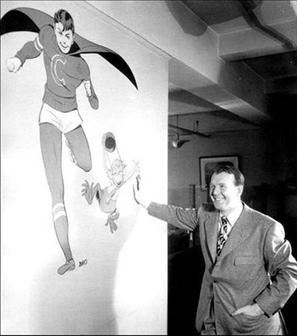Charles Biro facts for kids
Quick facts for kids Charles Biro |
|
|---|---|
 |
|
| Born | May 12, 1911 New York City, U.S. |
| Died | March 4, 1972 (aged 60) |
| Area(s) | Cartoonist, Writer, Penciller, Editor |
|
Notable works
|
Airboy Crime Does Not Pay Daredevil Comics |
Charles Biro (born May 12, 1911 – died March 4, 1972) was an American comic book creator. He was a talented cartoonist who helped shape the early days of comic books. He is famous for creating characters like Airboy and Steel Sterling. He also worked on popular comics such as Daredevil Comics and Crime Does Not Pay for Lev Gleason Publications.
Biography
Charles Biro grew up in New York City. He went to Stuyvesant High School and then studied art. He learned about art at the Brooklyn Museum School of Art and the Grand Central School of Art.
Around 1936, he started working at the Harry "A" Chesler Shop. This was one of the first studios that helped create comic books. Biro was a writer, artist, and later a supervisor there. In 1939, he moved to MLJ Comics and took on similar roles.
Biro was an art supervisor, writer, and artist for MLJ until 1941. He created characters like Steel Sterling and Sgt. Boyle. After that, he joined Lev Gleason Publications. He worked there for the next 15 years.
At Gleason, Biro was the editorial director, head writer, and cover artist. He focused mainly on creating exciting covers after 1942.
He helped create many comic books for Gleason. One popular character was Chuck "Crimebuster" Chandler. Crimebuster appeared in Boy Comics from 1942 to 1956. People described Crimebuster as a great boy hero in comics.
Daredevil Comics
Biro did a lot of work on crime comics. But he also worked on Daredevil, one of Gleason's longest-running titles. This Daredevil is not the same as the Marvel Comics character.
Biro was a writer and cover artist for Daredevil. He also drew much of the first issue, Daredevil Battles Hitler #1 (July 1941). He stayed with the title for many years. He made Daredevil one of the most popular heroes of the Golden Age of Comic Books.
Experts say that Daredevil was a very good superhero comic. Charles Biro helped it become a place for many different hero stories.
A comics encyclopedia called The World Encyclopedia of Comics said Biro did a "miraculous job" with Daredevil. Another encyclopedia, Comiclopedia, called his work on Daredevil "one of his most impressive feats."
Biro worked with other artists like Basil Wolverton and Dick Briefer on Daredevil Comics. In issue #13 (October 1942), Biro introduced the "Little Wise Guys." These were a group of young characters, similar to the Newsboy Legion from DC Comics. The Little Wise Guys included Curly, Jocko, Peewee, Scarecrow, and Meatball.
By the late 1940s, superheroes were becoming less popular. So, the Little Wise Guys became the main characters. Daredevil even became their mentor. Biro wrote Daredevil's adventures from 1941 to 1950. He continued writing "Little Wise Guys" stories until the series ended in 1956.
Other Comic Work
Charles Biro also worked for other comic companies. In 1938, he created the comic strip Goodbyland. He also worked on "Block & Fall" for Centaur Comics.
In 1941, he helped create the character Airboy for Hillman Periodicals. Airboy first appeared in Air Fighters Comics in November 1942. Airboy became one of Biro's most lasting creations. The character was brought back many times after 1953. Air Fighters Comics was even renamed Airboy Comics in 1945. Airboy comics ran for over 100 issues.
Later Life and Career
After leaving Gleason in 1956, Biro started working in television. He moved into graphic design. For the last ten years of his life, from 1962 to 1972, he worked as a graphic artist for NBC.
In the late 1960s, he visited a comic book convention. When people there realized who he was, they gave him a microphone. He spoke for 20 minutes about his career.
Charles Biro passed away on March 4, 1972. He was recognized for his important work in comics. He was nominated for the Eisner Hall of Fame in 1998 and 2000. He was officially added to the Hall of Fame in 2002. This award honors the best creators in comic books.

